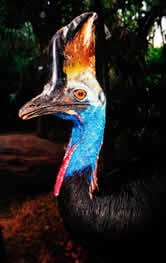Jan 22 2009
With Australia Day, the official national day of Australia, coming up on 26 January WWF-Australia has announced its own Australia Day Honours list - the top ten Aussie
Battlers of 2008!
 Road kills are one of the major causes of adult cassowary deaths in Australia. © WWF-Canon / Martin HARVEY
Road kills are one of the major causes of adult cassowary deaths in Australia. © WWF-Canon / Martin HARVEY
“Although our list celebrates Australian animals, it is also serves as a reminder that these Aussie Battlers need our help in order to survive,” said Kat Miller, WWF threatened species program manager.
“Without urgent action we risk losing more of the 346 animal and 1,249 plant species listed as threatened under federal legislation. Australia has the worst record of mammal extinction in the world,” Ms Miller said.
Nine per cent of birds, seven per cent of reptiles and 16 per cent of amphibians are either extinct or threatened in Australia.
“Half the mammals that have become extinct globally in the last 200 years have been Australian species. We cannot afford to let more of our unique Australian animals disappear forever,” she said.
Top of the list of Aussie Battlers is the green and gold frog. Forget the future impacts of climate change, one of Australia’s largest frogs has already had its home decimated by climate change-induced drought since 2005. Thanks to another group of Aussie Battlers, farmers in Lowbidgee, New South Wales, these patriotic frogs are getting a second chance.
Next in line is the cassowary. Being large and flightless isn’t much help when you’re crossing the road in Far North Queensland. Road kills are one of the major causes of adult cassowary deaths. With only 1,500 left in the wild can we afford to let this happen?
The green sawfish, which evolved from ancient sharks with a unique saw, lined with teeth made from modified scales, is a species of ray that looks out of place in northern Australian waters. But these animals are true blue Aussies as this may be the last place where significant numbers of green sawfish exist.
Historically the golden fur of the beautiful yellow-footed rock wallaby was more likely to be seen on a London high street than in outback Australia. Today many other threats remain, with less than 2,000 wallabies left in South Australia and possibly less than 500 in New South Wales.
With house prices skyrocketing, spare a thought for the red-tailed black cockatoo, Official Mascot of the Melbourne 2006 Commonwealth Games. Nesting hollows in south-eastern Australia are so scarce many of these endangered birds are left out in the cold.
Living in the World Heritage Listed Kakadu National Park doesn’t necessarily protect you from outside threats such as fire and weeds. It is thought the wild population of yellow-snouted geckos could be as low as 10.
The swift parrot has the longest migration journey of any parrot in the world, travelling from southern Queensland to Tasmania each year to breed. This speedy parrot has a bad habit of not looking where it’s flying and significant numbers are killed every year due to collisions with cars and home windows. With only 2,000 left in the wild, the loss of every bird is a tragedy.
As one of the ACT’s most threatened insects, the golden sun moth is critically endangered and has a very short lifespan, living just a few days as an adult. The female travels only a few hundred metres in this time due to her limited flying ability.
What's green and gold and woolly? The woolly wattle, which is closely related to Australia's national flower, the golden wattle, occurs only in a small patch in the Southwest Australia Ecoregion. The leaves and fruit of this plant are covered entirely by dense, long, soft, white hairs, making this the cuddliest wattle around.
The bridled nailtail wallaby was named for its horn-shaped 'nail' at the tip of the tail. Although once common throughout eastern Australia, it was believed to be extinct before being rediscovered in 1973 on a cattle station near Dingo, Queensland. Back from the brink but with only 400 left in the wild these Aussie Battlers need a helping hand to survive.